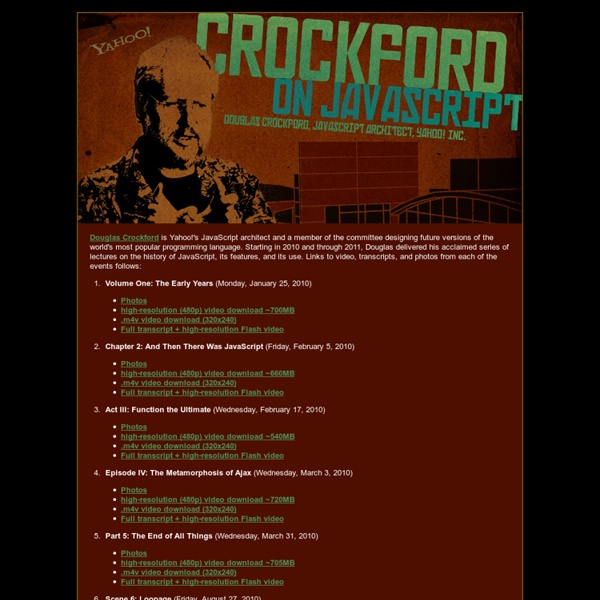



isaacs/slide-flow-control - GitHub A Look at Popcorn Today we’re going to take a look at Popcorn.JS, a library from Mozilla which makes it very easy to manipulate a webpage based on the current position of a video. This allows you to create rich “hypermedia” experiences around your video content. With Popcorn, you could display information about actors currently on-screen, or show Google Street View maps of locations in the video. Take a look at the Demo Page to see what we’ll be achieving – a mix of images, Google Maps, Wikipedia, tagging, RSS feeds, Facebook and web content – all in a 22 second video clip. About Popcorn Popcorn makes video work like the web. Popcorn provides a collection of plugins to easily pull in remote data to the screen. This pulls in the first 40 words from the Queen’s Wikipedia page into the element with an ID of wiki. You can just as easily display a Google Map: This displays a Google Map of England in #map at 10 seconds, and disappears at 12. Getting Started Create your file structure like so: Images Videos Done it?
JavaScript Tutorial Douglas Crockford Javascript Videos Douglas Crockford Javascript Videos 13 flv videos | 246MB+258MB+151MB+167MB+212MB+70MB | Total duration 6hr 24min Yahoo! JavaScript Architect Douglas Crockford covers JavaScript in a series of tutorial and lecture videos. Class 1 - The JavaScript Programming Language Yahoo! Part 1: 30:58 Part 2: 31:08 Part 3: 29:08 Part 4: 19:47 Class 2 - The Theory of the DOM Douglas Crockford teaches "An Inconvenient API: The Theory of the Dom." Part 1: 31:11 Part 2: 21:25 Part 3: 26:24 Class 3 - Advanced Javascript Douglas Crockford teaches "Advanced JavaScript." Part 1: 31:03 Part 2: 25:35 Part 3: 11:01 JavaScript, The Good Stuff Part 1: 39:37 Quality Yahoo! Part 1: 48:22 The State of AJAX Part 1: 38:32
The Seven Deadly Sins Of JavaScript Implementation - Smashing Magazine Advertisement Using JavaScript has become increasingly easy over the last few years. Whereas back in the day we needed to know the quirks of every browser, now many libraries such as jQuery, YUI, Dojo and MooTools allow someone who doesn’t even know JavaScript to spruce up boring HTML documents with impressive and shiny effects. By piggy-backing on the CSS selector engine, we have moved away from the complexity and inconsistencies of the DOM and made things much easier. If you look at some of the code that has been released, though, we do seem to have taken a step backwards. In gaining easier access, we also became a bit sloppy with our code. The rules for solid, maintainable and secure JavaScript haven’t changed, though. We’ve all had to work with code written by other people. Sins Of Our Fathers: Browser-Specific Code One of the main obstacles that kept us from evolving as developers was that JavaScript was largely browser-specific. Libraries to the Rescue What do I mean by these?
fjakobs/async.js - GitHub Lets Make a 3D Game: microphysics.js This post is part of the “Lets make a 3D game” series. 3D and physics simulation always go well together evenmoresowithmarblegames. One is required for marblesoccer but i wasnt convinced by current 3d physics engines. I explain why at the end. Fortunatly, @pyalot from codeflow.org has been kind enough to write one taylor-made for us: microphysics.js!! It is bite-sized, elegant and efficient. Below is a screencast of me doing a short introduction of the playground. Let’s get started So lets see how to use it. Let’s Create a World Quite a title hey ? Now you start it. The world is now fully initialized. The timeStep parameter is the precision of the physics engine, expressed in seconds. Let’s Add Bodies Don’t worry, this is not about killing people and dispose of their dead bodies :) In physics, A body is a solid object that you put in your world. microphysics bodies can be spheres or static boxes. Now lets add it to our world If you need to remove it, just do world.remove(sphere). Motivation
Learning JavaScript Design Patterns Design patterns are reusable solutions to commonly occurring problems in software design. They are both exciting and a fascinating topic to explore in any programming language. One reason for this is that they help us build upon the combined experience of many developers that came before us and ensure we structure our code in an optimized way, meeting the needs of problems we're attempting to solve. Design patterns also provide us a common vocabulary to describe solutions. In this book we will explore applying both classical and modern design patterns to the JavaScript programming language. Target Audience This book is targeted at professional developers wishing to improve their knowledge of design patterns and how they can be applied to the JavaScript programming language. Some of the concepts covered (closures, prototypal inheritance) will assume a level of basic prior knowledge and understanding. Acknowledgments Credits Reading Patterns are not an exact solution. Creational Design Patterns
How does JavaScript .prototype work? Web Standards Curriculum - Dev.Opera kriszyp/node-promise - GitHub Is there a better way of writing v = (v == 0 ? 1 : 0); - Stack Overflow - Vimperator